Abstract
Rates of oxalate degradation by mixed bacterial populations in cecal contents from wild rats ranged from 2.5 to 20.6 mumol/g (dry weight) per h. The oxalate-degrading activity in cecal contents from three strains of laboratory rats (Long-Evans, Wistar, and Sprague-Dawley) from four commercial breeders was generally lower, ranging from 1.8 to 3.5 mumol/g (dry weight) of cecal contents per h. This activity did not increase when diets were supplemented with oxalate. When Sprague-Dawley rats from a fifth commercial breeder were fed an oxalate diet, rates of oxalate degradation in cecal contents increased from 2.0 to 23.1 mumol/g (dry weight) per h. Obligately anaerobic, oxalate-degrading bacteria, similar to ruminal strains of Oxalobacter formigenes, were isolated from the latter group of laboratory rats and from wild rats. Viable counts of these bacteria were as high as 10(8)/g (dry weight) of cecal contents, which was less than 0.1% of the total viable population. This report presents the first evidence for the presence of anaerobic oxalate-degrading bacteria in the cecal contents of rats and represents the first direct measurement of the concentration of these bacteria in the large bowel of monogastric animals. We propose that methods used for the maintenance of most commercial rat colonies often preclude the intestinal colonization of laboratory rats with anaerobic oxalate-degrading bacteria.
Full text
PDF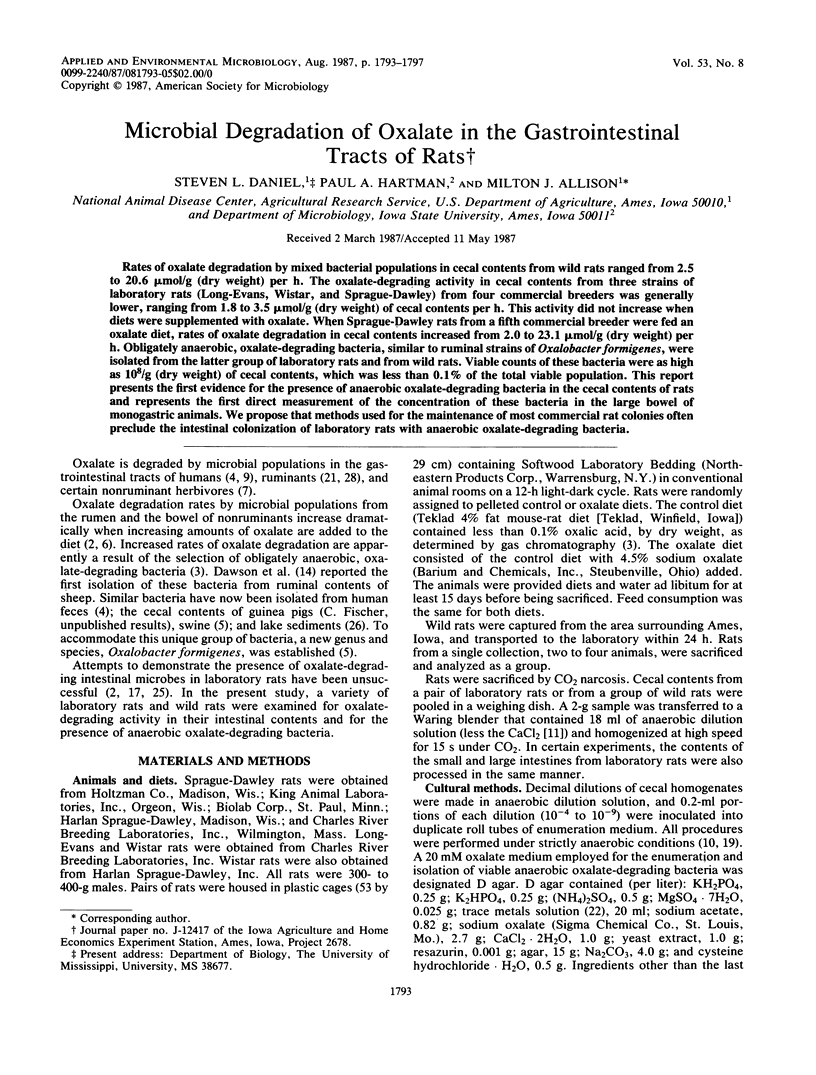
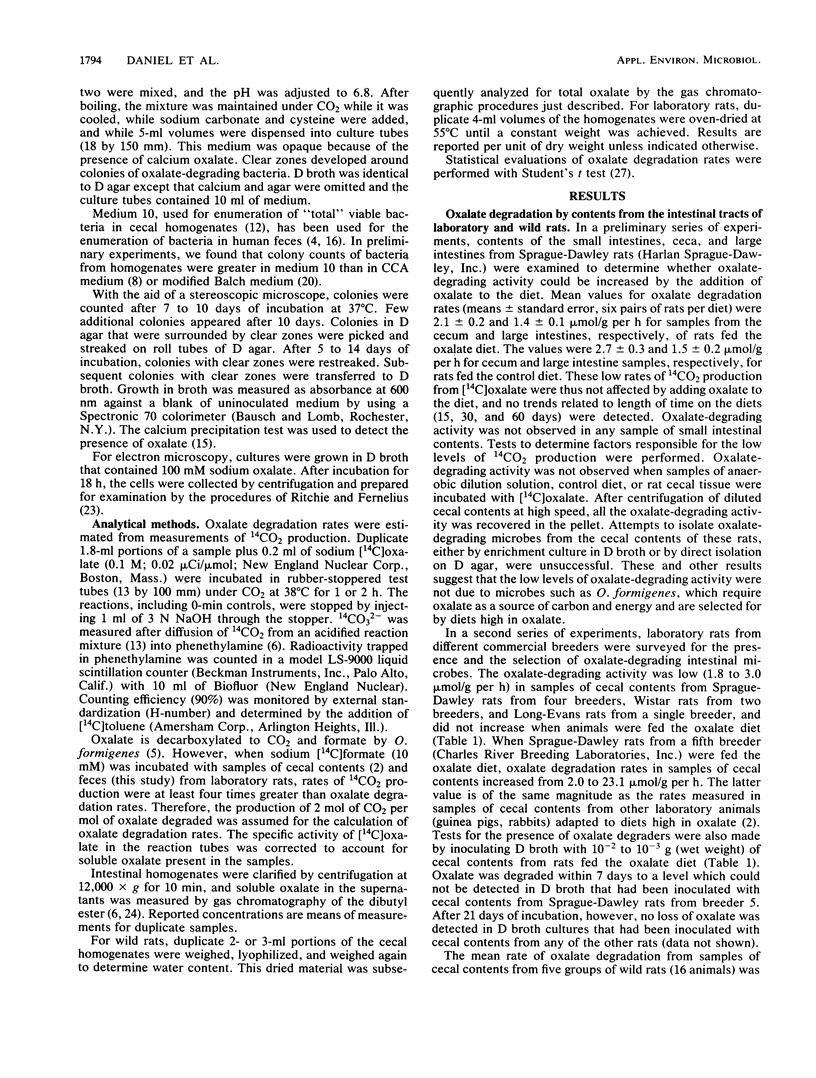
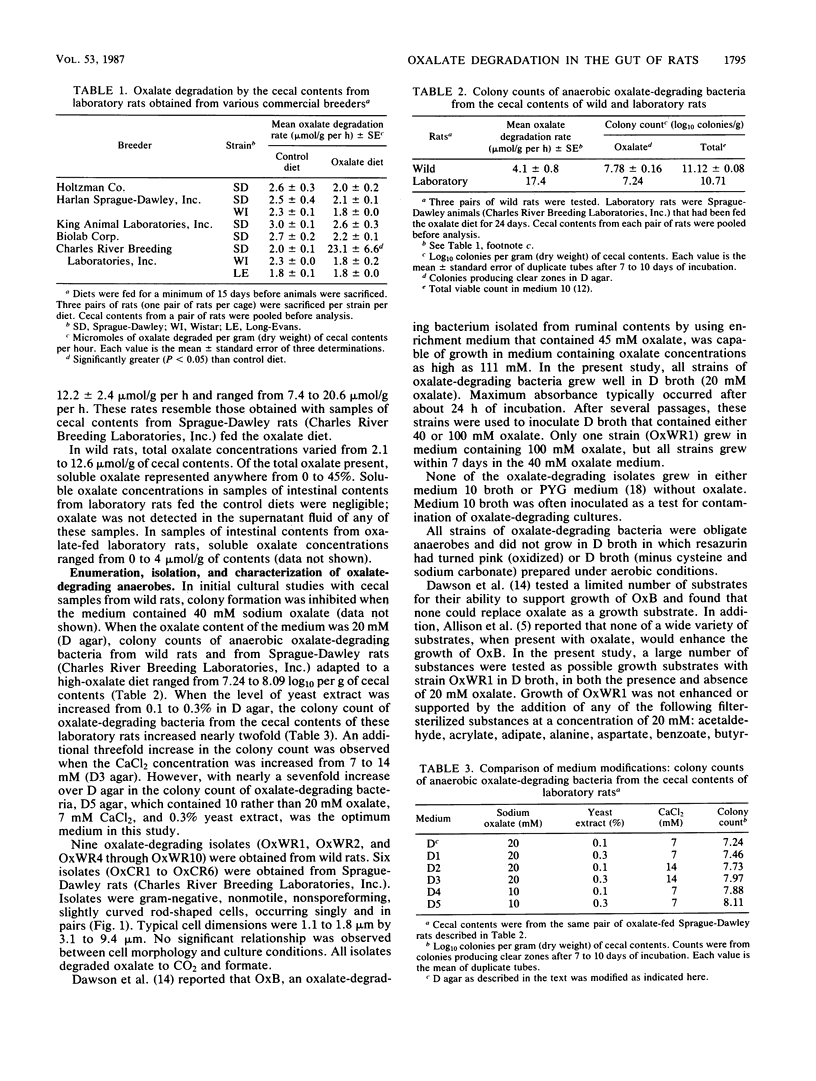
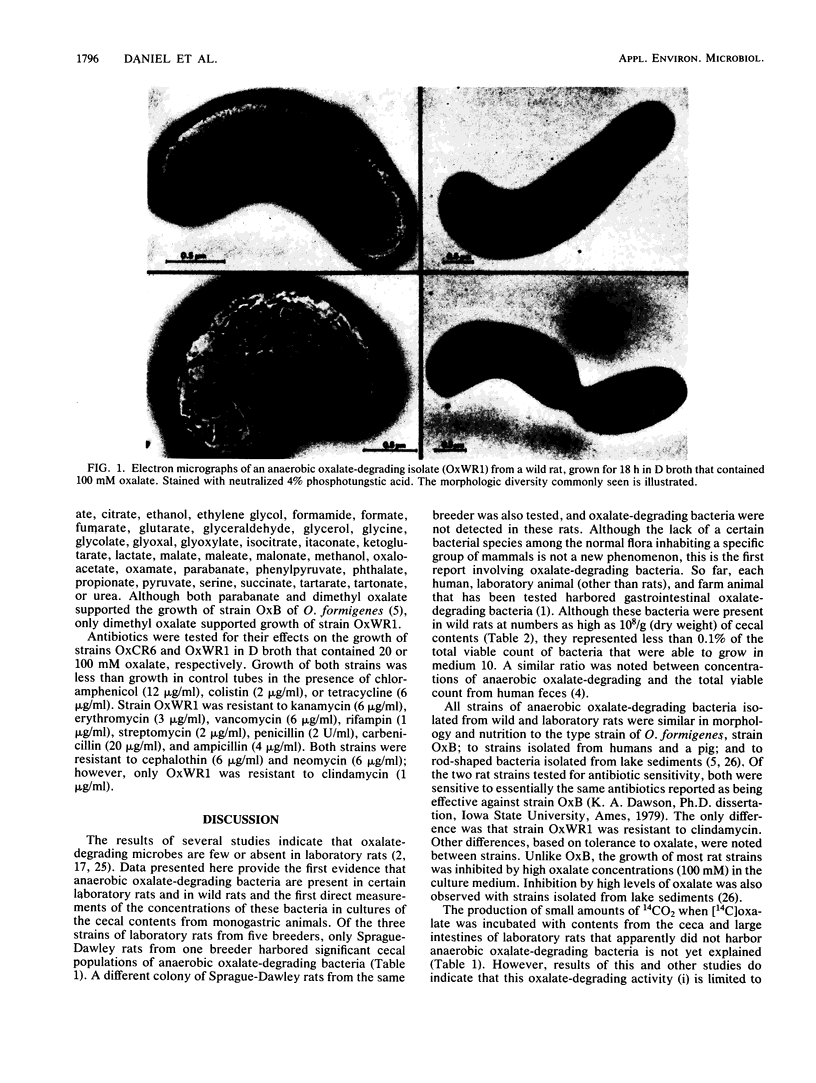
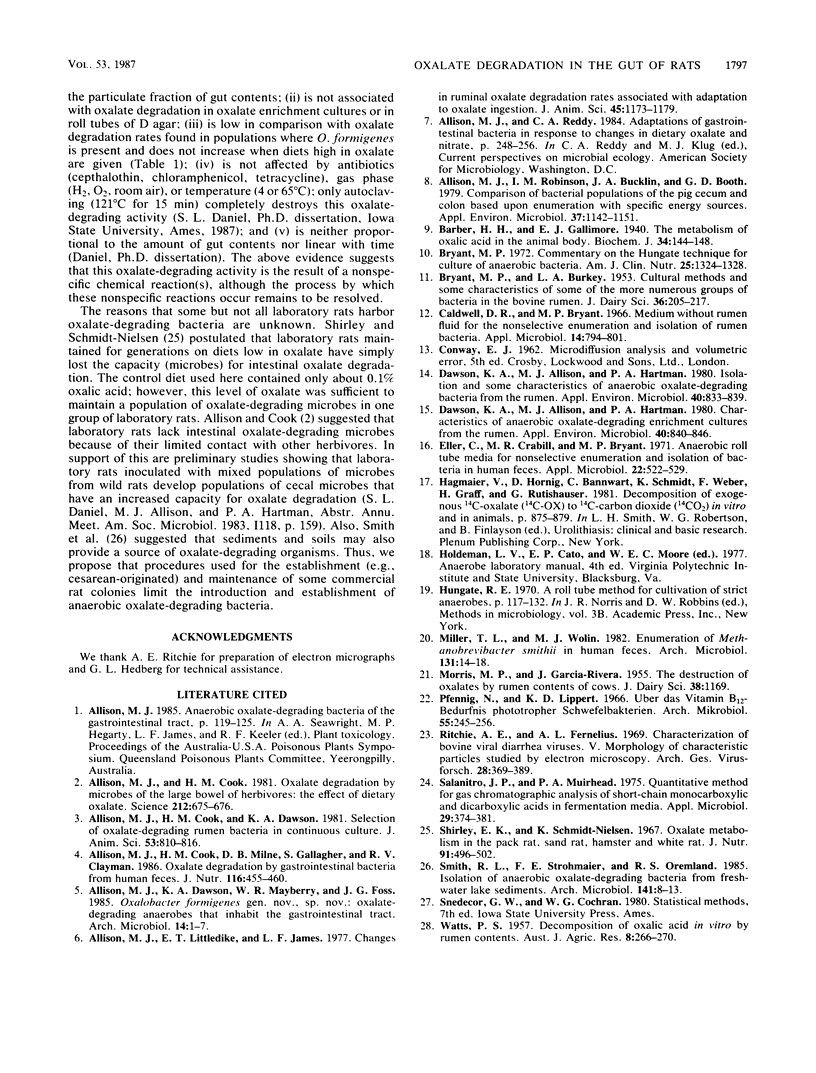
Images in this article
Selected References
These references are in PubMed. This may not be the complete list of references from this article.
- Allison M. J., Cook H. M., Milne D. B., Gallagher S., Clayman R. V. Oxalate degradation by gastrointestinal bacteria from humans. J Nutr. 1986 Mar;116(3):455–460. doi: 10.1093/jn/116.3.455. [DOI] [PubMed] [Google Scholar]
- Allison M. J., Cook H. M. Oxalate degradation by microbes of the large bowel of herbivores: the effect of dietary oxalate. Science. 1981 May 8;212(4495):675–676. doi: 10.1126/science.7221555. [DOI] [PubMed] [Google Scholar]
- Allison M. J., Dawson K. A., Mayberry W. R., Foss J. G. Oxalobacter formigenes gen. nov., sp. nov.: oxalate-degrading anaerobes that inhabit the gastrointestinal tract. Arch Microbiol. 1985 Feb;141(1):1–7. doi: 10.1007/BF00446731. [DOI] [PubMed] [Google Scholar]
- Allison M. J., Littledike E. T., James L. F. Changes in ruminal oxalate degradation rates associated with adaptation to oxalate ingestion. J Anim Sci. 1977 Nov;45(5):1173–1179. doi: 10.2527/jas1977.4551173x. [DOI] [PubMed] [Google Scholar]
- Allison M. J., Robinson I. M., Bucklin J. A., Booth G. D. Comparison of bacterial populations of the pig cecum and colon based upon enumeration with specific energy sources. Appl Environ Microbiol. 1979 Jun;37(6):1142–1151. doi: 10.1128/aem.37.6.1142-1151.1979. [DOI] [PMC free article] [PubMed] [Google Scholar]
- Barber H. H., Gallimore E. J. The metabolism of oxalic acid in the animal body. Biochem J. 1940 Feb;34(2):144–148. doi: 10.1042/bj0340144. [DOI] [PMC free article] [PubMed] [Google Scholar]
- Bryant M. P. Commentary on the Hungate technique for culture of anaerobic bacteria. Am J Clin Nutr. 1972 Dec;25(12):1324–1328. doi: 10.1093/ajcn/25.12.1324. [DOI] [PubMed] [Google Scholar]
- Caldwell D. R., Bryant M. P. Medium without rumen fluid for nonselective enumeration and isolation of rumen bacteria. Appl Microbiol. 1966 Sep;14(5):794–801. doi: 10.1128/am.14.5.794-801.1966. [DOI] [PMC free article] [PubMed] [Google Scholar]
- Dawson K. A., Allison M. J., Hartman P. A. Characteristics of anaerobic oxalate-degrading enrichment cultures from the rumen. Appl Environ Microbiol. 1980 Oct;40(4):840–846. doi: 10.1128/aem.40.4.840-846.1980. [DOI] [PMC free article] [PubMed] [Google Scholar]
- Dawson K. A., Allison M. J., Hartman P. A. Isolation and some characteristics of anaerobic oxalate-degrading bacteria from the rumen. Appl Environ Microbiol. 1980 Oct;40(4):833–839. doi: 10.1128/aem.40.4.833-839.1980. [DOI] [PMC free article] [PubMed] [Google Scholar]
- Eller C., Crabill M. R., Bryant M. P. Anaerobic roll tube media for nonselective enumeration and isolation of bacteria in human feces. Appl Microbiol. 1971 Oct;22(4):522–529. doi: 10.1128/am.22.4.522-529.1971. [DOI] [PMC free article] [PubMed] [Google Scholar]
- Miller T. L., Wolin M. J. Enumeration of Methanobrevibacter smithii in human feces. Arch Microbiol. 1982 Feb;131(1):14–18. doi: 10.1007/BF00451492. [DOI] [PubMed] [Google Scholar]
- Ritchie A. E., Fernelius A. L. Characterization of bovine viral diarrhea viruses. V. Morphology of characteristic particles studied by electron microscopy. Arch Gesamte Virusforsch. 1969;28(3):369–389. doi: 10.1007/BF01240951. [DOI] [PubMed] [Google Scholar]
- Salanitro J. P., Muirhead P. A. Quantitative method for the gas chromatographic analysis of short-chain monocarboxylic and dicarboxylic acids in fermentation media. Appl Microbiol. 1975 Mar;29(3):374–381. doi: 10.1128/am.29.3.374-381.1975. [DOI] [PMC free article] [PubMed] [Google Scholar]
- Shirley E. K., Schmidt-Nielsen K. Oxalate metabolism in the pack rat, sand rat, hamster and white rat. J Nutr. 1967 Apr;91(4):496–502. doi: 10.1093/jn/91.4.496. [DOI] [PubMed] [Google Scholar]



